The 1957 wheat penny is an interesting coin that can be found in many collections. If you have come across one of these coins, you might be wondering how much it is worth. Judging the coin by face value might mislead you as this coin can be worth more than you expect.
If you want to know whether it is worth your time to track down a 1957 coin for your collection, this guide is for you. We will go over the history of the coin, why it may be valuable, and whether it is a must-have coin or not.
How much is the 1957 Penny Worth?
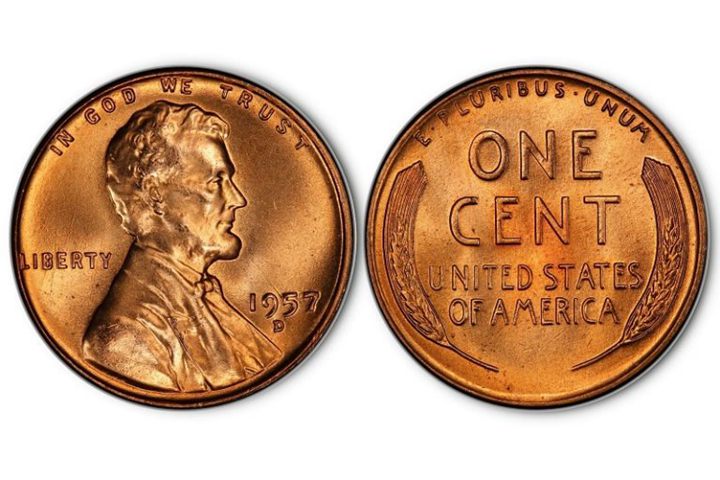
The worth of a 1957 Lincoln cent depends on its condition and its rarity. A 1957 coin worth adding to a collection would have to be in mint state or be a rare coin. On average, a 1957 penny can cost the following prices.
| Date | Good | Fine | Extremely fine | Uncirculated |
| 1957 | $0.05 | $0.11 | $0.16 | $1 |
| 1957 D | $0.05 | $0.11 | $0.16 | $1 |
A limited number of 1957-proof coins were also minted. There were only about 1.2 million of these coins. 1957 proof coins can go for up to $10 depending on their condition.
The highest-selling 1957 coin to be sold went for thousands of dollars. That coin was graded a nearly perfect MS-67 Red. The grading was done by the coin authentication firm, Professional Coin Grading Service (PCGS).
The coin was sold at an auction in 2007 for the price of $12,075.
What is a 1957 wheat Penny?
A wheat penny is a one-cent coin that was minted between the years 1909 and 1958. The heads side of the coin, or the obverse side, bears the image of President Abraham Lincoln. The reverse side bears the image of two wheat stalks, giving the coin its name.
On the obverse side, the words ‘In God We Trust’ can be seen above the President’s head while the word ‘Liberty’ is printed on his right and the date and mint mark, if any, are on his left.
The reverse side has the words ‘ONE CENT’ at the center with the stalks of wheat arcing around it. The words ‘UNITED STATES OF AMERICA’ is printed beneath. Above the stalks are the words ‘E. PLURIBUS UNUM’, meaning ‘out of many, one’.
The coin was designed by Victor David Brenner and, before the wheat penny run, one-cent coins were known as the Indian Head Penny. The wheat penny was made with President Lincoln’s image to honor his 100th birthday.
In the first run of wheat pennies launched in 1909, Victor David Brenner had his initials put on the coin. This signature was later removed about a decade later but it was brought back. By the run of the 1957 coin, the “VBD” initial can be seen on the penny once more, under President Lincoln’s shoulder.
What is a 1957 Penny Made of?
Wheat pennies were made up of a mix of different metals. These metals include copper, tin, and zinc. The mixing percentages for these metals are 95% copper and 5% tin and zinc. As copper is now considered a precious metal, some might think that the wheat coin is now worth much more than expected.
This is false because the value of a coin is not judged by what precious metals it is made of. Rather it is judged by its popularity, rarity, and condition.
What makes a 1957 Penny Rare?
The rarity and therefore the worth of a penny are dependent on many things. These things often have to do with the condition of the penny at present.
The first thing that determines the rarity of wheat pennies is their condition. This means whether the coin is worn down or uncirculated. The mint mark of the penny also determines whether it is rare or not.
Pennies could either be minted at the Philadelphia mint which means that they don’t have any mint marks or at the Denver mint, where coins were marked with the letter “D”.
The next thing that can make a 1957 penny rare is the presence of errors and variations. These could include doubled die strikes, off-center strikes, die cracks, and many more.
Depending on all these factors, your 1957 coin could be a rare gem or just another coin in your purse.
How much is an Uncirculated 1957 Penny Worth?
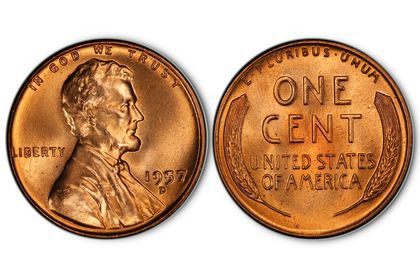
The signs of an uncirculated coin can be seen with the naked eye. The surface of the coin is without blemish and the design is completely intact. The luster of the coin is also intact.
One way to note the quality of a 1957 coin is by taking a look at Lincoln’s hair. The top of his hair should show the details of his curls with luster and without any wear to the coin. You can also take a look at his coat lapel for the quality of the coin.
If his hair and coat are of the same metal quality and texture as the rest of the coin, you can be sure that the coin is uncirculated.
Understanding how to identify the penny means that you can properly gauge its value. On average, an uncirculated 1957 penny could be sold for up to $10. Some uncirculated pennies may still have some slight signs of distress so, the fewer the blemishes on the coin, the higher it can be sold for.
What errors are on a 1957 Penny?
Coin errors are signs of wear, distress, or minting mistakes that make coins unique. Coin errors usually lead to an increase in the coin values. This is because the coin with the error becomes a collectible among coin collectors.
Here are some examples of coin errors that can be found in the 1957 penny:
Lamination error
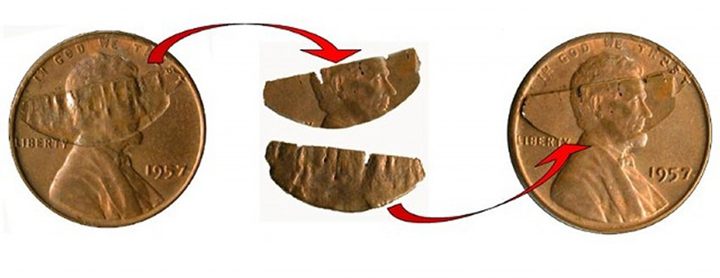
This is an error on 1957 mint coins that can be found on a few. Both Philadelphia mint and Denver mint coins can contain this error.
The lamination error happens in the alloying process of the coin. While the metals to create the coin are being mixed, an error can lead to the surface of the coin having small imperfections in the metal. This is seen as small splits in the metal surface.
The lamination error can make coins more valuable because it increases the rarity of the coin.
BIE error
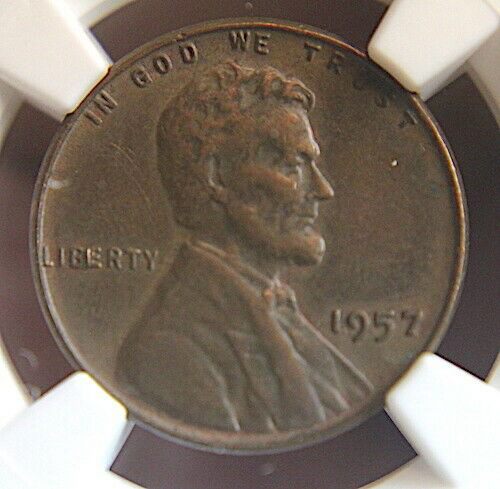
The BIE error in 1957 coins is a phenomenon in these coins where there is a die crack between the letters “B” and “E” in the word “LIBERTY”. This results in the coin looking like it says “LIBIERTY”.
The BIE error has been noted and documented by many coin collectors and is a very popular error. Die cracks or die breaks occur when a coin has a crack in the metal. This is usually due to the wear and tear of the coin over time.
Coins with the BIE error are considered somewhat valuable and are collectibles. The BIE error is not an error of minting or printing but a consequence of time passed on the coin. BIE error coins can go for up to $7 each.
Check out this video to see the BIE error up close:
Die clash
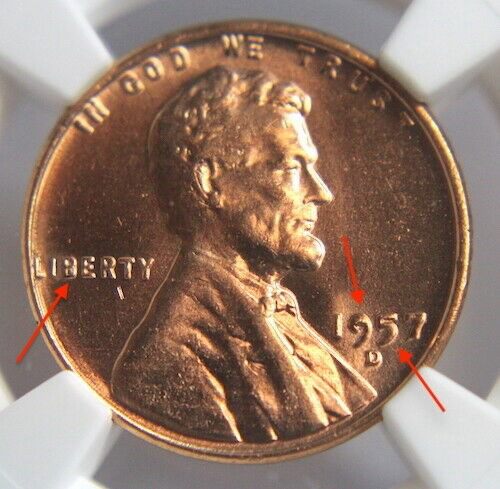
This is a type of error that happens when dies come together when there is no planchet in the coining chamber. This leads to designs of one coin being transferred to another.
An example of die clash 1957 coins are coins that have a “9” printed on their date. This error makes coins valuable as they are very rare.
Doubled die
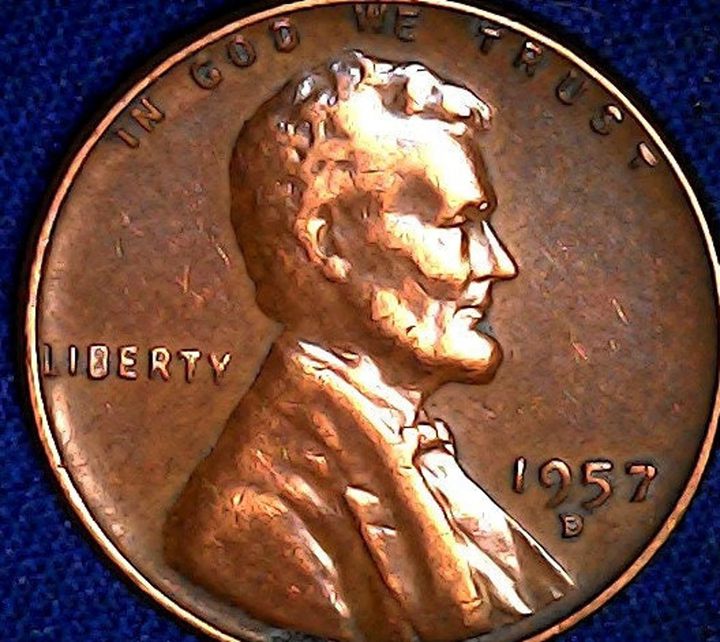
The doubled die error in pennies is an error that shows up as a result of errors when coin designs are being transferred. This leaves the coin with two impressions of the design on its surface, resulting in a doubled die.
Doubled die errors are very popular errors that increase their value. A doubled die 1957 coin could have the doubling show on any part of the coin, from the lettering to the two stalks to Lincoln’s image.
Doubled die coins continue to garner interest among collectors which means that they are always valuable. This is because they are interesting to look at and examine. A 1957 Lincoln wheat penny with a double die error can be sold for up to $10.
1957 D Penny and its value
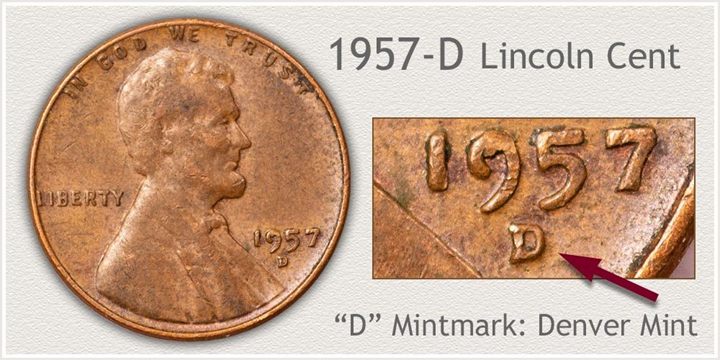
The 1957 D penny refers to 1957 wheat coins that were made at the Denver mint. They can be identified with the mint mark of a small letter D underneath the date. Coins minted at the Philadelphia mint had no mint mark and the San Francisco mint did not make any 1957 coins.
The 1957 D penny is slightly rarer than the average 1957 penny because of its mintage number, which is the third-highest of the wheat coins. These coins are very popular.
How to Sell a 1957 Wheat Penny
As a holder of a 1957 penny, you may be wondering where you can sell it and connect with other coin lovers. There are a few options for where you can sell your 1957 Lincoln penny. Here are a few options for how to sell your coin.
Authenticate your coin first
You should first get your coin authenticated by a coin grading company. This helps you to verify that your coin is legitimate and not a fraud. It is best to get your coin authenticated by a professional body than an independent coin dealer.
Having an authenticated coin is essential when you are trying to sell. This saves you the hassle of trying to convince people that your coin is legit.
Visit coin dealers and shops
Your local coin dealer is a great option for selling your wheat pennies. You can look up what coin shops are around you or contact a dealer to see your coin.
When selling to a dealer or shop, make sure that they have experience with similar coins to yours. If you have a rate 1957 penny or a coin with an error, you don’t want to sell it to someone who doesn’t know the value of the coin.
Try out an auction
Auctions, both physical and online are great choices for where to sell your coin. The atmosphere of an auction increases the demand for a coin which means it can sell higher.
Auctions are also a good place to meet with other coin collectors and view rare collections. Even if you are not going to sell, it can be fun to visit and auction and get a look at what coins are on sale and how the process works.
Where you can Buy 1957 Wheat Pennies
If you are looking for a new addition to your collection, a 1957 penny might be what you need. There are many ways to buy one of these wheat pennies. Here are a few.
Online sellers
Independent sellers that have come into possession of 1957 coins may want to sell them online. This is one of the easiest ways to buy a coin but also one of the easiest ways to buy a fake coin. When buying from an online vendor, you have to verify that their coin is not fake.
People sell their coins on all kinds of platforms such as Amazon and eBay.
Auction houses
As mentioned earlier, an auction is a great place for coin trading. You can look up information about upcoming auctions that have 1957 pennies up for sale. Auctions are a great place to buy rare coins as well.
Conclusion
There are many aspects of the 1957 coin that determines its value. Ultimately, whether you want one of these pennies in your collection or not is up to you. Whatever you choose to do with your 1957 wheat penny, whether sell it or display it, what matters the most is that you understand the value of the coin. Remember that even if your coin is very worn and circulated, you should never try to clean a coin as this will permanently distort its appearance, reducing its value further.
